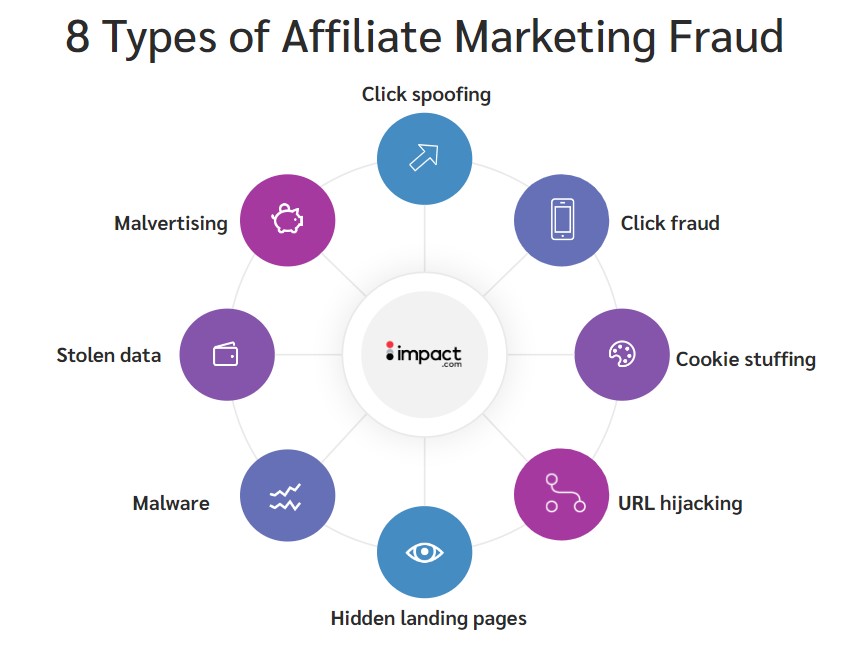Affiliate marketing is a booming industry worth $17 billion as of 2023—and brands using this channel see an incredible return on investment (ROI). But unfortunately, with an opportunity for partners to earn commissions, affiliate programs make brands vulnerable targets for scammers.
Affiliate fraud is increasing at a rapid rate. In 2020, nearly 10 percent of affiliate traffic proved to be fake. Yet only two years later, fraudulent clicks accounted for 17 percent of 2022’s affiliate traffic and costed companies an estimated $3.4 billion.
Preventing affiliate fraud—and the losses that come with it—starts with understanding:
- What is affiliate fraud and why it happens?
- 8 Types of affiliate fraud
- 6 Ways to prevent affiliate fraud
From there, advertisers can find the right policies, processes, and tools to minimize their fraud risk. Here’s everything advertisers need to know to mitigate affiliate fraud.
What is affiliate fraud and why does it happen?
Affiliate fraud occurs when scammers use malicious tactics to earn commission payouts from affiliate marketing programs. These tactics allow scammers to generate fake leads or claim sales attribution they didn’t contribute towards. Ultimately, affiliate fraud leads to excessive payouts for scammers, loss of income for actual affiliates, poor return on investment (ROI), and brand damage for advertisers.
3 Reasons why affiliate fraud happens:
- The program’s reward system is flawed.
- The acceptance criteria for accepting new affiliates are too lenient.
- Affiliates discover new fraud techniques.

Most advertisers design their affiliate program’s reward system to incentivize high performers. Scammers know they can manipulate this system and make it seem like their website is driving conversions for advertisers. Essentially, if the fraudsters can appear as if they’re generating more money, they end up earning more money.
Additionally, affiliate program managers may need to do more due diligence before accepting a new affiliate partner when they are eager to grow their affiliate program. Overly lenient acceptance criteria may make it appear like an affiliate program is successful, but it can also inadvertently introduce scammers into the program.
However, strict acceptance criteria or terms and conditions aren’t enough to prevent all affiliate fraud. Scammers discover new techniques and loopholes to commit fraud daily, and keeping up with the latest fraud methods takes time and effort. These techniques can go undetected for months or years, costing the company countless dollars.
Types of affiliate marketing fraud you should know
Partner program fraud can take many forms, so it’s important to know what to look for. These tactics are the most common types of affiliate fraud companies face.

1. Click spoofing
When an advertiser collects click data from a publisher, they don’t see where their clicks come from. Scammers can use click spoofing—or triggering invalid click events—even if a user doesn’t engage with a link. Then, the scammer gets paid if the user buys from the advertiser.
2. Click fraud
Scammers commit click fraud by leveraging a network of bots that mimic human behavior to trigger thousands of click events. The scammer gets paid for generating a considerable volume of leads.
3. Cookie stuffing
This involves automatically dropping cookies on a user’s browser when they visit the scammer’s website. When the user eventually buys from the advertiser, the fraudster gets paid.
4. Hidden landing pages
Publishers trigger hidden landing pages containing affiliate links to open and drop cookies without the user’s knowledge. The scammer gets paid when the user buys something from the advertiser.
5. URL hijacking or sneaky redirects
URL hijacking involves buying a similar domain name to the company or product. The scammer triggers an event click when a user clicks on the domain before immediately redirecting the user to the actual website. When the user completes their order, the scammer gets paid.
6. Malware
Adept scammers can design malware that inserts their affiliate code automatically whenever a user makes a purchase. The scammer gets paid whenever an infected user buys something from the advertiser.
7. Using stolen data
Scammers use lead forms or malware to steal user data like credit card information. Then, they use that data to make affiliate purchases or generate fake leads for the advertiser.
8. Malvertising
With malvertising, scammers purchase ad space on other websites and serve ads with infected code. When a user clicks on the ad, they inadvertently download a virus that generates more clicks for an advertiser’s site. Clicking on the ad also drops a cookie, so the scammer will make a commission if the user buys something later.
6 ways to prevent affiliate fraud
Once affiliate marketers know what to look for, preventing affiliate fraud doesn’t have to be complicated. These six actionable steps can help advertisers strengthen their affiliate programs to avoid affiliate fraud.

1. Define clear affiliate terms and conditions
Most types of affiliate fraud aren’t illegal unless they violate a formal terms and conditions document. Using the affiliate fraud types above as a guide, define what behavior is unacceptable within the affiliate program. The terms should clearly state the consequences of those behaviors too.
2. Enforce those terms
Train employees on the terms and conditions and review them regularly. For many affiliate teams, employees will play a vital role in identifying and addressing abnormal behavior. Therefore these teams should know what to look for and how to respond if they detect fraud.
Leveraging tools can help teams of any size better enforce their terms. Fraud detection tools work as an automated affiliate watchdog, allowing advertiser teams to focus more on their work and less on policing affiliates.
3. Be prepared to take action
A comprehensive terms and conditions document works alongside legal documents so advertisers aren’t held legally responsible for the affiliates in their network. But, these documents should also give advertisers a way to hold scammers accountable for violating the terms.
Design a process for how the team handles suspected fraud, including documentation procedures, investigation workflows, and action plans for offenses. While some instances of fraud could be accidental, advertisers should still issue warnings to affiliates who violate the terms and maintain a record of who receives a warning.
4. Monitor traffic
Traffic patterns can reveal abnormal behavior even earlier than a fraud detection tool. Collect a rich data set—including IP addresses and referring URLs—to recognize abnormalities early on. Plus, discovering affiliate partner patterns through comparison reports can help define baseline behavior so that fraud appears more obvious.
5. Connect with partners
Developing a personal connection with affiliate partners allows advertisers to perform their due diligence while helping legitimate partners improve. Review data patterns together to give advertisers insight. This practice helps both parties understand goals and business practices, and creates a level of comfort when working together.
6. Don’t auto-approve affiliates
Only performing due diligence after a partner joins the network may be too late. Instead, give the program manager more time to inspect affiliate requests and enforce more substantial acceptance criteria.
When an affiliate joins, extend offers with built-in fraud screening services to better verify affiliates and suppress fraudulent behavior before it happens.
Using fraud detection and prevention software
Preventing affiliate fraud manually demands a ton of time and resources. These manual processes can quickly become hard to manage—especially as affiliate programs grow. That’s where fraud detection and prevention software comes in.
A powerful fraud prevention software like impact.com can provide essential fraud detection tools. These tools give advertisers like you exceptional visibility into traffic patterns and user behaviors. Access fraud reports and detailed reason codes to quickly detect and handle fraud.
Then use impact.com’s machine learning-based fraud scoring and gain deep insights into your partners’ performance and their data. Discover and stop suspicious payments, lower attribution risks with better traffic data, and detect stolen or recycled leads.
This way, you can set aside fraud concerns and focus on creating stronger partnerships with trusted affiliates.
Affiliate fraud prevention made easy
Cybersecurity isn’t typically top-of-mind for advertisers. But, as affiliate fraud continues to increase, it’s time for organizations to take better control of data.
impact.com’s Ad Fraud Protect and Monitor works seamlessly with the Partnership Management Platform, giving advertisers the capabilities to quickly detect and prevent affiliate fraud. With powerful technology at your fingertips, focus on what matters most: developing strong partnerships and building an affiliate program that drives revenue.
Design your affiliate program with security tools you can count on. Check out PXA’s Protect and Monitor course to learn more about shielding your affiliate program against fraud.




